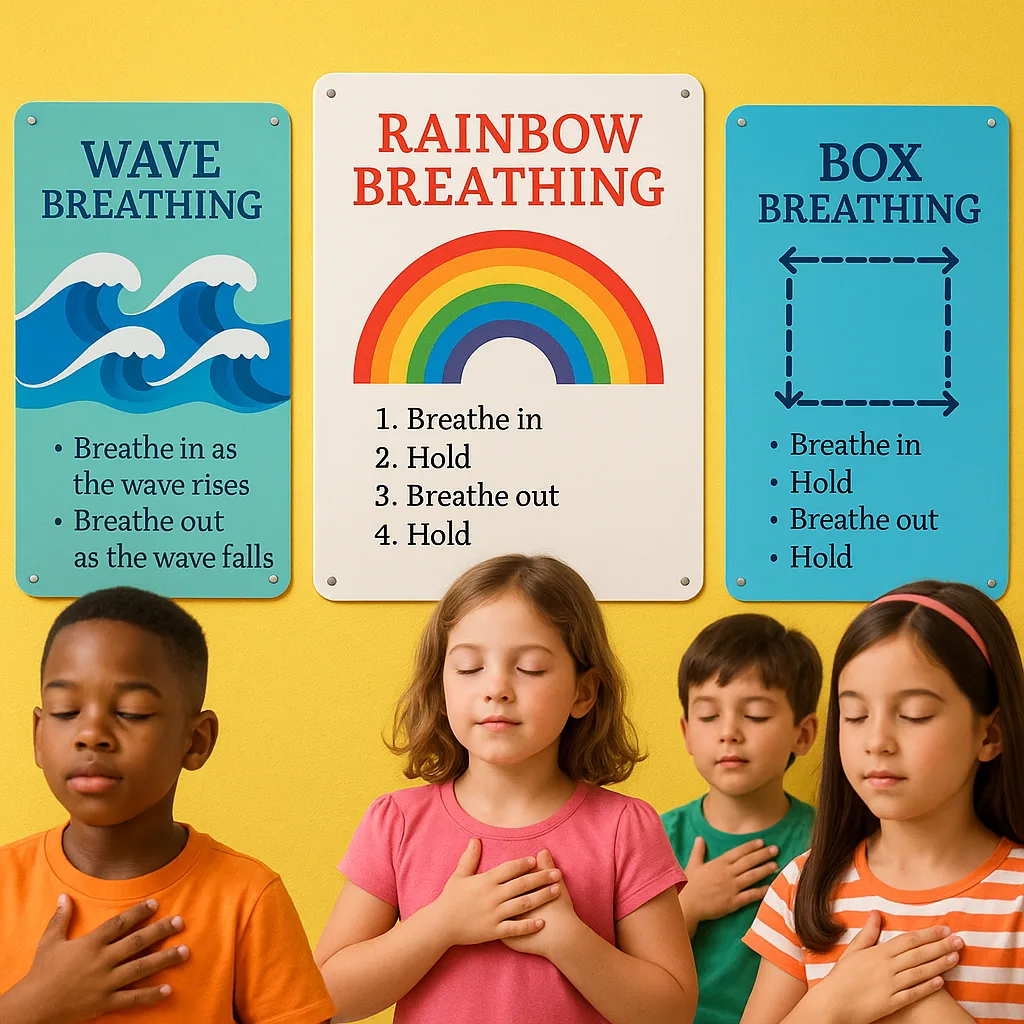Poster Machines for Test Anxiety Relief
The Science Behind Visual Breathing Stations
Research from Stanford’s stress lab shows that visual anchors combined with breathing exercises can reduce cortisol levels by up to 23% in just five minutes. Moreover, when students engage with carefully designed visual breathing boards, their parasympathetic nervous system activates, creating a physiological state conducive to clear thinking and emotional regulation.
In my workshops across the country, I’ve seen how a simple printer for posters can become a lifeline for anxious students. Furthermore, these visual tools work because they engage multiple sensory pathways simultaneously—sight, breath, and kinesthetic awareness—creating a powerful calming effect that traditional verbal instructions alone cannot achieve.

Poster Machines for Test Anxiety: Essential Design Elements
Creating effective visual breathing boards requires thoughtful design grounded in psychological principles. Therefore, each element must serve a specific purpose in guiding students through the breathing process while maintaining visual appeal.
Color Psychology Matters: Cool blues and greens activate the rest-and-digest response, while warm earth tones provide grounding. Additionally, avoiding high-contrast combinations prevents visual overstimulation during vulnerable moments.
Shape and Flow: Circular patterns naturally guide the eye in rhythmic movements that mirror breathing cycles. Similarly, wave-like designs can help students visualize the ebb and flow of breath, making abstract concepts tangible.
Strategic Text Placement: Minimal, well-spaced text in rounded fonts reduces cognitive load. Consequently, students can focus on the breathing technique rather than decoding complex instructions.
Quick Breathing Techniques
Seconds to inhale
Seconds to hold
Seconds to exhale
The 4-7-8 breathing technique, visualized through calming posters, helps reset the nervous system in under two minutes.
Implementing Breathing Stations Across Your School
Strategic Placement Locations
Testing Room Entrances: Position calming visuals where students naturally pause before entering. Subsequently, this creates a transition ritual that signals the brain to shift into a focused, calm state.
Hallway Alcoves: Transform unused corners into mini meditation zones. Furthermore, these semi-private spaces allow anxious students to practice breathing without feeling exposed.
Library Study Areas: Install permanent stations where students prepare for tests. Meanwhile, the quiet environment naturally reinforces the calming message.
Counseling Office Waiting Areas: Support students seeking help by providing immediate coping tools. Additionally, this normalizes stress management as part of academic success.
Creating Your Breathing Board System
Start with a comprehensive assessment of your school’s testing schedule and high-stress areas. Therefore, map out locations where students congregate before exams or show signs of anxiety.
Next, develop a cohesive visual language across all stations. Similarly, consistent design elements help students quickly recognize and utilize these resources, regardless of location. Our poster machines enable you to create professional-quality visuals that maintain consistency while allowing customization for different age groups.
Finally, involve students in the creation process. Consequently, peer-designed breathing boards often resonate more deeply with the student body, increasing engagement and effectiveness.
Research-Based Breathing Technique Templates
Each technique below has been validated through peer-reviewed studies and adapted for visual learning environments.
Box Breathing
Equal counts for inhale, hold, exhale, holdImplementation Tips
Create a square visual path with numbered corners. Moreover, use arrows to guide eye movement clockwise, matching the breathing rhythm. This geometric approach appeals to logical learners.Rainbow Breathing
Trace rainbow arcs with synchronized breathDesign Elements
Use gradient colors transitioning from cool to warm. Furthermore, add small clouds at arc endpoints for pause visualization. Young learners especially connect with this playful yet effective technique.Ocean Wave Breath
Breath flows like waves on shoreVisual Cues
Design undulating wave patterns with varying heights. Additionally, incorporate subtle bubble animations or foam details to represent breath release points.Maximizing Impact Through Design
The most effective breathing boards combine several key psychological principles. First, they must be immediately accessible—students in distress need instant visual guidance without complex interpretation. Therefore, clarity trumps creativity in critical moments.
Second, incorporate progressive complexity. Meanwhile, beginners can follow simple patterns while advanced practitioners engage with nuanced variations. This scaffolding approach ensures longevity and continued engagement with the stations.
Third, consider cultural sensitivity in imagery and color choices. Subsequently, what calms one student might trigger another based on personal or cultural associations. Diverse representation in calming imagery helps all students feel included and supported.
Pro Tip: Use your printer for posters to create seasonal variations of breathing boards. Furthermore, this keeps the stations fresh and engaging throughout the school year while maintaining core therapeutic elements.
Measuring Success and Adapting
“The beauty of visual breathing stations lies not just in their immediate impact, but in their ability to create lasting change in how students approach challenges.”
Track the effectiveness of your breathing stations through multiple metrics. Initially, observe usage patterns—which designs attract the most engagement? Additionally, collect anonymous feedback through QR codes linked to simple surveys displayed on the posters themselves.
Monitor academic performance data, particularly comparing test scores before and after implementation. However, remember that success isn’t solely measured in grades. Consequently, reduced nurse visits for anxiety symptoms, improved classroom behavior, and increased student self-advocacy all indicate positive impact.
Regular refinement keeps your stations relevant. Therefore, involve your school counseling team in quarterly reviews, incorporating new research findings and student suggestions. Our versatile poster machines make updates cost-effective and timely.
Remember, every poster you create with care becomes a beacon of calm in a student’s storm. Through mindful design and strategic placement, your visual breathing boards can transform testing season from a time of dread to an opportunity for growth and self-discovery.

